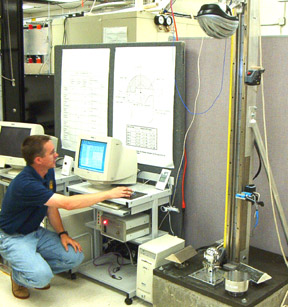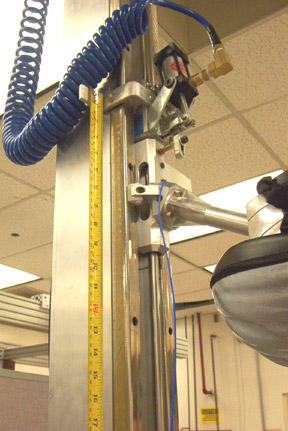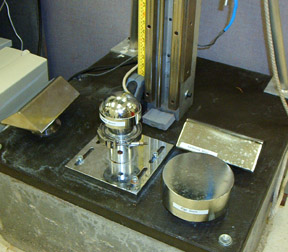How Bicycle Helmets are Tested
Summary: This page describes the lab tests that bike helmets must pass to meet the CPSC standard. There is other testing related to lead content that we do not cover. CPSC has a video of this testing up on their website.
The testing to certify a helmet to the US Consumer Product Safety Commission's standard for bicycle helmets can be described in six steps.
1. Samples required
The lab must procure samples of the helmet model. Full compliance testing requires 16 samples. The lab also needs a number from the manufacturer called the Helmet Positioning Index (HPI). It specifies the measurement to place the helmet correctly on the headform.
2. Marking
The lab technician puts the first sample on a test headform the right size to fit it. The headform is mounted upright on a stand, usually on a flat table. The helmet is adjusted using the HPI and then a 5 kilogram (10.x pound) cloth bag filled with lead shot is placed on it to compress any fitting foam inside. A marker on a stand is adjusted to the right level, using a measurement from a table in the standard that varies by helmet size. With the marker against the helmet the test line is marked by either rotating the helmet or sliding the marker stand around it. Each sample is marked in turn.
The lab test impacts must all be centered on or above the test line. The area below the line is not tested, although
the "footprint" of an impact centered on the test line will extend below the line, and the helmet is not likely to pass
if there is no material there. To get an idea of where the test line is marked, you can take a medium-sized helmet and
measure on the inside 68mm straight down below the highest inside point. Then mark that level on the outside of the
helmet, all the way around. Put the helmet on your head and you will see that the test line is higher than it should be,
and the area of the helmet tested is really not large enough. The Snell Memorial Foundation's bicycle helmet standard has
a lower test line. Even the old ANSI standard adopted in 1984 and now dead had a lower test line.
3. Conditioning
Helmets are tested hot, wet, cold and room temperature.
- Four samples are heated to 47 to 53 degrees C. (117 to 127 degrees F)
- Four samples are chilled to -13 to -17 degrees C. (55 to 63 degrees F)
- Four samples are soaked in potable water at a temperature of 15 to 23 degrees C. (59 to 73 degrees F)
- Four samples are tested dry and ambient room temperature (59 to 73 degrees F)
4. Strap test
Next comes the strap strength and "rolloff" testing. Here is one test rig. There are other designs, but they all function the same.

Photos from the CPSC test lab in Gaithersburg, MD
5. Drop tests
The helmet is now ready for drop testing. It is strapped onto a headform, held upside down on a test rig that guides its fall onto an anvil. This rig in the CPSC lab is a monorail, and the drop is guided by a single rail. Others use two parallel wires (twinwire).

 The lab technician raises the helmet and
headform up until the top of the helmet is a specified distance from the anvil below. A trigger lets the helmet drop in
free fall until the helmet hits the anvil. The velocity of the drop is checked just before the impact to ensure that the
speed was correct. An instrument called an accelerometer measures g's in the center of the headform. If the helmet works
well, the g's are low--probably below 200, and in the better helmets below 150. If the g's exceed 300, the helmet fails.
The testing is on three anvils of different shapes:
The lab technician raises the helmet and
headform up until the top of the helmet is a specified distance from the anvil below. A trigger lets the helmet drop in
free fall until the helmet hits the anvil. The velocity of the drop is checked just before the impact to ensure that the
speed was correct. An instrument called an accelerometer measures g's in the center of the headform. If the helmet works
well, the g's are low--probably below 200, and in the better helmets below 150. If the g's exceed 300, the helmet fails.
The testing is on three anvils of different shapes:
- The flat anvil is used with a 2 meter drop. The helmet and headform are traveling at 14 mph at impact.
- The hemispheric anvil shown below, about the shape of a grapefruit, is used with a 1.2 meter drop. (The point load
makes it a severe test.) The helmet and headform are traveling 11 mph at impact.

- The hazard or curbstone anvil is rounded like the edge of a curb. It is another severe test, and the drop is 1.2 meters (11 mph).
6. Records
The CPSC standard requires the lab to keep records of the testing. That includes data on the helmet and data on performance.
Pass or Fail
The bottom line is that the helmet must pass all of the tests described above. If it fails on any of them, it cannot be certified to the standard. You don't meet a standard "except for . . ." A failure on any element of the tests is a complete failure.We have more on testing and standards
- Bike helmet standards
- Comparison of different standards
- Calculations including a spreadsheet
- Limits of helmet protection
And elsewhere you can find
- CPSC's video of their lab testing.
- The Snell Foundation's standards and a video of Snell's lab test procedures.
- YouTube is a dynamic site, and videos are posted there every day. We recommend that you do a search there for more.
Back to the top
Back to the Home Page